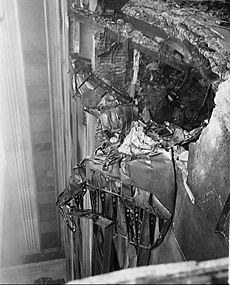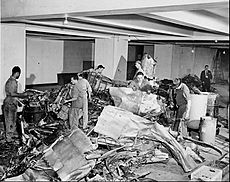1945 Empire State Building B-25 crash facts for kids

The Empire State Building on fire following the crash
|
|
| Accident summary | |
|---|---|
| Date | July 28, 1945 (80 years ago) |
| Summary | Controlled flight into terrain (building) in inclement weather conditions (fog). |
| Place | Empire State Building, New York City |
| Fatalities | 3 |
| Survivors | 0 |
| Aircraft type | B-25 Mitchell |
| Aircraft name | Old John Feather Merchant |
| Airline/user | United States Army Air Forces |
| Registration | 41-30577 |
| Flew from | Bedford Army Air Field Bedford, Massachusetts |
| Flying to | Newark Metropolitan Airport |
On July 28, 1945, something unusual happened in New York City. A B-25 Mitchell bomber plane, belonging to the United States Army Air Forces, accidentally flew into the famous Empire State Building. This happened because of very thick fog. The crash sadly resulted in fourteen deaths: three people on the plane and eleven people inside the building. About twenty-four other people were hurt. The damage to the building was about $1 million (which would be much more today!), but the building itself was still strong and safe.
Contents
The Plane Crash
On Saturday, July 28, 1945, a pilot named Lieutenant Colonel William Franklin Smith Jr. was flying a B-25 Mitchell bomber. He was on a regular trip from Bedford Army Air Field in Massachusetts to Newark Metropolitan Airport in New Jersey.
What Happened During the Flight
As he got closer to New York, the fog became extremely thick. The airport told him that he couldn't see anything. Even so, he kept going. The thick fog made him lose his way. After flying past the Chrysler Building, he turned right instead of left.
At 9:40 in the morning, the plane crashed into the north side of the Empire State Building. It hit between the 78th and 80th floors. The crash made a large hole, about 18 by 20 feet, in the building. This hole led into offices of the War Relief Services and the National Catholic Welfare Council.
Impact and Fire
One of the plane's engines shot through the building's south side. It flew almost a whole block away, then dropped 900 feet. It landed on the roof of a nearby building. This caused a fire that destroyed an art studio on the top floor. The other engine and part of the landing gear fell down an elevator shaft inside the Empire State Building.
Firefighters quickly arrived. They put out the fire in just 40 minutes. This fire was the highest structural fire ever put out by firefighters at that time.
People Affected
When the crash happened, between 50 and 60 tourists were on the 86th floor observation deck. Sadly, fourteen people died. This included Colonel Smith, Staff Sergeant Christopher Domitrovich, and Albert Perna, who was riding along. Eleven people inside the building also lost their lives. Around twenty to twenty-four other people were injured because of the crash.
After the Crash
Even with the damage and the sad loss of lives, the building was ready for business again very quickly. Many floors were open on the next Monday morning, less than 48 hours later.
Changes After the Accident
The crash helped a new law get passed. It was called the Federal Tort Claims Act. President Harry S. Truman signed it into law in August 1946. This law made it possible for people to sue the government if they were harmed in accidents like this one.
After all the plane parts and debris were cleaned up, a businessman named Armand Hammer bought the damaged 78th floor. He fixed it up and made it the main office for his company, United Distillers of America.
Another Close Call
Almost exactly a year after the crash, on July 24, 1946, another plane nearly hit the building. This plane was not identified and had no military markings. It flew past the 68th floor and scraped the observation deck. This surprised the workers and tourists who were there.
See also
 In Spanish: Choque del B-25 contra el Empire State Building para niños
In Spanish: Choque del B-25 contra el Empire State Building para niños
- 1946 40 Wall Street Plane crash
- El Al Flight 1862
- September 11 attacks
- 2002 Tampa airplane crash
- 2002 Pirelli Tower airplane crash
- 2005 Iranian Air Force C-130 crash
- 2006 New York City plane crash
- 2014 Wichita King Air crash
- Skyscraper fire



